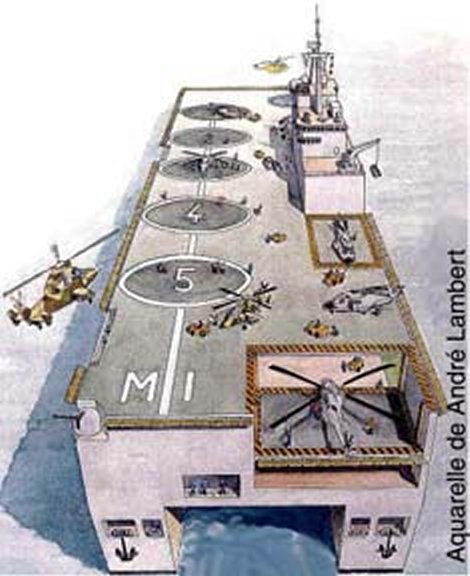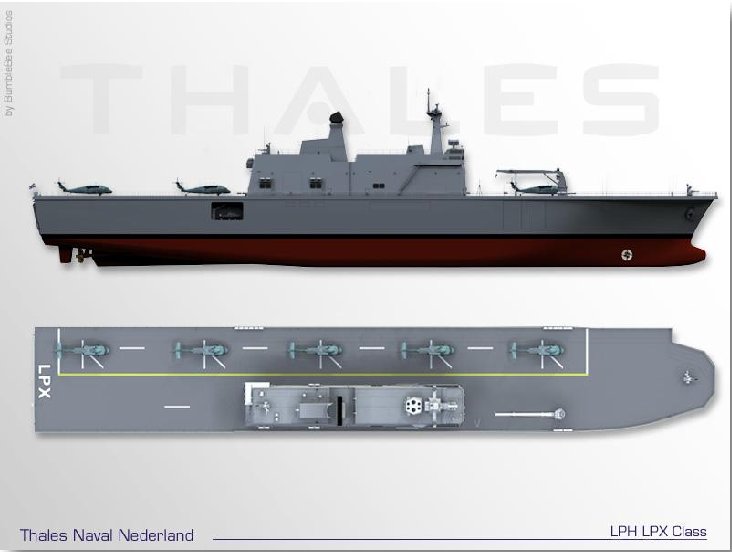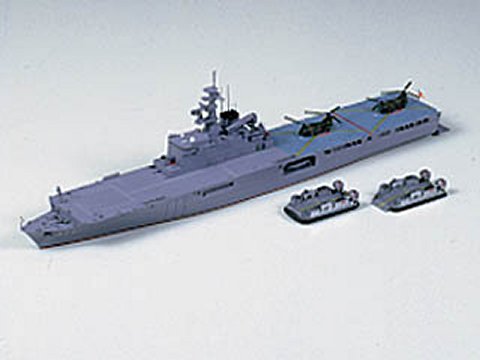Being 200 meters long, 31 meters wide and displacing 14,000 tons [18,000 fully loaded], the ship will carry 700 troops, 10 CH-60 helicopters, seven amphibious vehicles, six tanks and two small landing boats. The ships can be used in a wide range of activities, including UN peacekeeping operations and disaster relief. For this reason, the LP-X is expected to usher in a new era of expanded Korean naval prowess, since it can be used for relief, transport, and other peacetime activities.
With a light displacement of 14,000 tons the LP-X is not only be the largest vessel in the Korean Navy but also substantially larger than the similar Osumi-class landing ship (8,900 tons) of the Japanese Maritime Self-Defense Force, and with a larger payload capacity as well, making it the regions largest of its kind. Previously, the largest ship in the Korean Navy was the 9,000-ton support vessel Cheonji.
The LPX is a high-speed amphibious ship, based on the concept of "over-the- horizon assault." As the name indicates, the "over-the-horizon assault" comprises a military operation in which an amphibious landing operation is conducted with high-speed air-cushioned vehicles and helicopters from beyond the horizon, where they can’t be detected or attacked by the enemy. The conventional LST (landing ship tank) has to approach the coastline for landing, at the risk of being fired upon by the enemy.
The LP-X can carry a battalion of marines (about 700 men), 10 armored vehicles, up to 200 vehicles, 15 helicopters, and two LCAC hovercrafts capable of landing on enemy shores doing 40 knots -- a mix that enables it to launch troop landings from both sea and air.
The hull consists of four decks, this highest of which is the 1st deck [the flight deck], with the bridge superstructure. The flight deck can accomodated five UH-60 helicopters simultaneously. When the budget situation is improved, there is the possibilty that the NH-90 or the E101 Merlin will be adopted. An airplane hanger can be added for the UH-60 transportation helicopter and the AH-1 attack helicopter. An airplane shed spanning the lower deck is planned with multilayer structure and 2 formation elevator and 1 cadence elevator.
If it were equipped with a ski jump board module, 15-17 meters in length, it could operate short-range and vertical landing/take-off aircraft such as the Harrier or F-35B. Ships of this type are sometimes called a semi-aircraft carrier. However, Korean military authorities have made it clear that they have no plan to convert the LPX into such a semi-aircraft carrier. However, its flight deck is coated with special Urethane to resist heat generated from aircraft.
The 2nd deck is composed with the rooms of the dwelling sector, the command post and utility system of the crew. It will be able to accommodate a landing party with a strength 700 persons.
The 3rd deck includes the well-dock for loading the 2 LCACs. It is able to load 70 tanks or 200 truck, but normally the load is 10 helicopters and 2 tank companies, along with their support equipment. While being entirely mechanized, it will be able to accommodate 1 battalion strength and the equipment and armament.
At the lower part stern there is an entrance and exit door which is how the LCAC comes in and out. The LCAC is accommodated with a length and width of 26.4m X 14.3m. It loads the equipment with a total weight of 60-75 ton fullly loaded, and can sustain a speed 74Km/hr (40 knot). At this speed the cruise range is 320Km, and at 65Km/hr (35 knot) the range is 480Km. Generally it will be able to embark the individual basic load strength of 1 tank with 2 squads together. The LCAC is able to attempt landing in the coastal areas of 70% of the coasts. After landing it is able to operate in even until more deeply inland.
The LP-X is a multi-functional vessel. It can also function as a command vessel for the Navy’s three-dimensional mobile operations. A combat commanding system, equipped with a digital C41SR function, can manage and control support vessels, aircraft and their weapons, on a real-time basis, so that the landing troops can make a prompt and effective response to the enemy’s status. In other words, it can serve as a base vessel that commands a strategic mobile operation fleet consisting of KDX-III (Aegis vessel) and KDX-II (Korean destroyer) vessels and submarines. The LP-X can function as the flagship with a command bridge established on the deck top island. The battle command system with the digital C41SR function was purchased in 2002 for 52,900,000,000 won [about $50,000,000].





